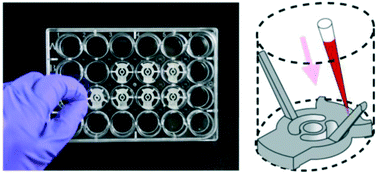Our official English website, www.x-mol.net, welcomes your
feedback! (Note: you will need to create a separate account there.)
Upgrading well plates using open microfluidic patterning†
Lab on a Chip ( IF 6.1 ) Pub Date : 2017-11-22 00:00:00 , DOI: 10.1039/c7lc00878c Samuel B. Berry 1, 2, 3, 4 , Tianzi Zhang 1, 2, 3, 4 , John H. Day 1, 2, 3, 4 , Xiaojing Su 1, 2, 3, 4 , Ilham Z. Wilson 1, 2, 3, 4 , Erwin Berthier 1, 2, 3, 4 , Ashleigh B. Theberge 1, 2, 3, 4, 5
Lab on a Chip ( IF 6.1 ) Pub Date : 2017-11-22 00:00:00 , DOI: 10.1039/c7lc00878c Samuel B. Berry 1, 2, 3, 4 , Tianzi Zhang 1, 2, 3, 4 , John H. Day 1, 2, 3, 4 , Xiaojing Su 1, 2, 3, 4 , Ilham Z. Wilson 1, 2, 3, 4 , Erwin Berthier 1, 2, 3, 4 , Ashleigh B. Theberge 1, 2, 3, 4, 5
Affiliation

|
Cellular communication between multiple cell types is a ubiquitous process that is responsible for vital physiological responses observed in vivo (e.g., immune response, organ function). Many in vitro coculture strategies have been developed, both in traditional culture and microscale systems, and have shown the potential to recreate some of the physiological behaviors of organs or groups of cells. A fundamental limitation of current systems is the difficulty of reconciling the additional engineering requirements for creating soluble factor signaling systems (e.g., segregated cell culture) with the use of well-characterized materials and platforms that have demonstrated successful results and biocompatibility in assays. We present a new open-microfluidic platform, the Monorail Device, that is placed in any existing well plate or Petri dish and enables patterning of segregated coculture regions, thereby allowing the direct upgrade of monoculture experiments into multiculture assays. Our platform patterns biocompatible hydrogel walls via microfluidic spontaneous capillary flow (SCF) along a rail insert set inside commercially available cultureware, creating customized pipette-accessible cell culture chambers that require fewer cells than standard macroscale culture. Importantly, the device allows the use of native surfaces without additional modification or treatments, while creating permeable dividers for the diffusion of soluble factors. Additionally, the ease of patterning afforded by our platform makes reconfiguration of the culture region as simple as changing the rail insert. We demonstrate the ability of the device to pattern flows on a variety of cell culture surfaces and create hydrogel walls in complex and precise shapes. We characterize the physical parameters that enable a reproducible SCF-driven flow and highlight specialized design features that increase the ease of use of the device and control of the open microfluidic flow. Further, we present the performance of our platform according to useful coculture criteria, including permeability and integrity of our hydrogel walls and surface-sensitive cell culture. Lastly, we show the potential of this type of platform to create modular multikingdom culture systems that can be used to study soluble factor signaling between mammalian cells, bacteria, and fungi, as well as the potential for adaptation of this technology by researchers across multiple fields.
中文翻译:

使用开放式微流控图案升级孔板†
多种细胞类型之间的细胞通讯是普遍存在的过程,其负责体内观察到的重要生理反应(例如,免疫反应,器官功能)。在传统的培养和微型系统中,已经开发了许多体外共培养策略,并显示出重现器官或细胞群的某些生理行为的潜力。当前系统的基本局限性在于难以协调创建可溶因子信号系统的其他工程要求(例如(分离的细胞培养)),并使用特征明确的材料和平台,这些材料和平台已证明在分析中具有成功的结果和生物相容性。我们提出了一种新的开放式微流体平台Monorail设备,该平台可放置在任何现有的孔板或培养皿中,并能够对分离的共培养区域进行图案化,从而将单培养实验直接升级为多培养实验。我们的平台可通过以下方式对生物相容性水凝胶壁进行图案化微流控自发毛细管流(SCF)沿设置在市售培养皿内的导轨插入物,创建了定制的移液器可触及细胞培养室,该室比标准的大规模培养所需的细胞更少。重要的是,该设备无需使用任何其他修饰或处理即可允许使用天然表面,同时创建可渗透的分隔物以溶解可溶性因子。此外,我们平台提供的易于图案化功能使培养区域的重新配置与更换导轨插入件一样简单。我们展示了该设备能够在各种细胞培养表面上图案化流动并创建复杂且精确形状的水凝胶壁的能力。我们表征了可重现SCF驱动流的物理参数,并重点介绍了专门的设计功能,这些功能增加了设备的易用性和开放微流体流的控制。此外,我们根据有用的共培养标准(包括水凝胶壁的渗透性和完整性以及表面敏感的细胞培养)提出了平台的性能。最后,我们展示了这种平台在创建模块化多王国培养系统中的潜力,该系统可用于研究哺乳动物细胞,细菌和真菌之间的可溶性因子信号传导,以及研究人员在多个领域对这种技术的适应性。包括我们水凝胶壁的渗透性和完整性以及对表面敏感的细胞培养物。最后,我们展示了这种平台在创建模块化多王国培养系统中的潜力,该系统可用于研究哺乳动物细胞,细菌和真菌之间的可溶性因子信号传导,以及研究人员在多个领域对这种技术的适应性。包括我们水凝胶壁的渗透性和完整性以及对表面敏感的细胞培养物。最后,我们展示了这种平台在创建模块化多王国培养系统中的潜力,该系统可用于研究哺乳动物细胞,细菌和真菌之间的可溶性因子信号传导,以及研究人员在多个领域对这种技术的适应性。
更新日期:2017-11-22
中文翻译:

使用开放式微流控图案升级孔板†
多种细胞类型之间的细胞通讯是普遍存在的过程,其负责体内观察到的重要生理反应(例如,免疫反应,器官功能)。在传统的培养和微型系统中,已经开发了许多体外共培养策略,并显示出重现器官或细胞群的某些生理行为的潜力。当前系统的基本局限性在于难以协调创建可溶因子信号系统的其他工程要求(例如(分离的细胞培养)),并使用特征明确的材料和平台,这些材料和平台已证明在分析中具有成功的结果和生物相容性。我们提出了一种新的开放式微流体平台Monorail设备,该平台可放置在任何现有的孔板或培养皿中,并能够对分离的共培养区域进行图案化,从而将单培养实验直接升级为多培养实验。我们的平台可通过以下方式对生物相容性水凝胶壁进行图案化微流控自发毛细管流(SCF)沿设置在市售培养皿内的导轨插入物,创建了定制的移液器可触及细胞培养室,该室比标准的大规模培养所需的细胞更少。重要的是,该设备无需使用任何其他修饰或处理即可允许使用天然表面,同时创建可渗透的分隔物以溶解可溶性因子。此外,我们平台提供的易于图案化功能使培养区域的重新配置与更换导轨插入件一样简单。我们展示了该设备能够在各种细胞培养表面上图案化流动并创建复杂且精确形状的水凝胶壁的能力。我们表征了可重现SCF驱动流的物理参数,并重点介绍了专门的设计功能,这些功能增加了设备的易用性和开放微流体流的控制。此外,我们根据有用的共培养标准(包括水凝胶壁的渗透性和完整性以及表面敏感的细胞培养)提出了平台的性能。最后,我们展示了这种平台在创建模块化多王国培养系统中的潜力,该系统可用于研究哺乳动物细胞,细菌和真菌之间的可溶性因子信号传导,以及研究人员在多个领域对这种技术的适应性。包括我们水凝胶壁的渗透性和完整性以及对表面敏感的细胞培养物。最后,我们展示了这种平台在创建模块化多王国培养系统中的潜力,该系统可用于研究哺乳动物细胞,细菌和真菌之间的可溶性因子信号传导,以及研究人员在多个领域对这种技术的适应性。包括我们水凝胶壁的渗透性和完整性以及对表面敏感的细胞培养物。最后,我们展示了这种平台在创建模块化多王国培养系统中的潜力,该系统可用于研究哺乳动物细胞,细菌和真菌之间的可溶性因子信号传导,以及研究人员在多个领域对这种技术的适应性。









































 京公网安备 11010802027423号
京公网安备 11010802027423号